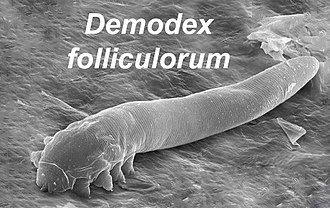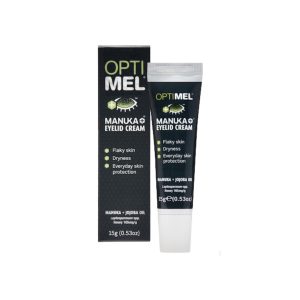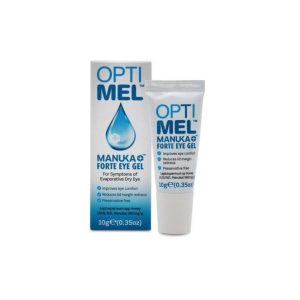Are you experiencing persistent dryness, irritation, or discomfort in your eyes? If so, you could be among the many individuals suffering from chronic dry eye syndrome, which may be linked to Demodex mites. These minuscule, eight-legged organisms are a natural part of the human skin microbiome, particularly around the eyes and eyelids. However, when their population exceeds normal levels, it can prompt inflammation and worsen the symptoms of dry eye syndrome, leading to significant discomfort and distress.
If you have been dealing with unexplained dry eye problems, it is crucial to explore whether Demodex mites might be a contributing factor to your symptoms. This comprehensive guide aims to help you identify the signs of a Demodex infestation, clarify the connection between these mites and dry eye disease, and provide you with effective treatment options to manage their population and alleviate your discomfort.

Recognizing and Understanding the Symptoms of Demodex Blepharitis
Individuals affected by Demodex Blepharitis or an overpopulation of these mites often experience a range of distinct symptoms that can significantly impact their quality of life. Common manifestations include:
- Burning, stinging, or gritty sensations in the eyes, particularly noticeable towards the end of the day, which can be both irritating and distracting.
- Unexplained excessive tearing or watery eyes that are not caused by allergies, leading to discomfort and potential embarrassment.
- Red, inflamed eyelids, along with irritation of the skin surrounding the eyes that can be visually distressing.
- Crusty, dandruff-like buildup along the lashes and lid margins, often manifesting as collarettes, which can be unsightly and bothersome.
- Extreme sensitivity to light, often making it feel as if your eyes are constantly squinting, which can hinder daily activities.
- Episodes of blurred vision that fluctuate throughout the day, creating uncertainty and frustration.
Many individuals endure these dry eye symptoms for years without recognizing that a Demodex mite infestation could be a significant underlying cause. Identifying these symptoms is a crucial step towards effectively addressing the root issue and reclaiming comfort in your daily life.

Exploring How Demodex Mites Lead to Distressing Dry Eye Symptoms
Ever wondered how these minuscule creatures can lead to such troubling dry eye symptoms? Demodex mites thrive on the oils and cells present on the skin, particularly within the hair follicles of your eyelashes. As they feed on these substances, they leave behind waste products, eggs, and remnants of deceased mites, which accumulate along the lid margins. This buildup creates a thick layer of debris and a bacterial biofilm that can obstruct the vital oil glands essential for maintaining optimal eye health.
When these oil glands fail to release sufficient oils, it results in the rapid development of dry patches on the eye surface. This oily tear film is crucial for preventing the quick evaporation of the watery tears that keep our eyes moist and comfortable. The inflammation triggered by the blockage can further intensify eye irritation, redness, and the uncomfortable gritty sensation that is commonly associated with dry eye conditions.
Mastering the Life Cycle of Demodex Mites for Effective Treatment Strategies
Understanding the life cycle of Demodex mites is essential for implementing effective treatment strategies against these pests. These mites transition through various stages: egg, larva, nymph, and adult, over a life cycle that typically spans approximately 14 to 21 days. They are most active during the night, leaving their hair follicles to mate and lay new eggs on the skin’s surface.
This nocturnal behavior suggests that the optimal time to apply Demodex treatments is during the evening, just before bedtime. By targeting the mites when they are most active, you can significantly enhance the effectiveness of your treatment. However, due to their rapid reproductive capabilities, any surviving mites can quickly repopulate, making continuous treatment essential over several weeks or even months to achieve lasting results and relief.
Effective Methods for Managing Demodex-Related Dry Eye Symptoms
If your optometrist confirms a high count of Demodex mites through eyelash sampling or microscopic examination, they may recommend a variety of treatment options to combat the infestation and alleviate symptoms:
1. Harnessing Tea Tree Oil Eyelid Wipes and Scrubs for Targeted Relief
Products containing tea tree oil are renowned for their powerful antimicrobial and antiparasitic properties, making them exceptionally effective in eradicating mites. These formulations can effectively eliminate surface mites, break down collarettes produced by these pests, and help draw out hidden mites, rendering them more susceptible to treatment.
While tea tree oil is an effective weapon against mites, it can cause stinging upon application and may be cytotoxic to healthy cells, potentially exacerbating symptoms for some patients.
Regular use of tea tree oil eyelid wipes or scrubs before bedtime can gradually decrease the mite population. One notable example of a potent tea tree oil treatment is OcuSoft Oust Foam, which is particularly effective for managing blepharitis primarily caused by Demodex mites and restoring comfort to your eyes.
2. Utilizing Gentle Hypochlorous Acid Lid Hygiene Sprays for Safe and Effective Use
Hypochlorous acid is a naturally occurring substance produced by our immune system, functioning as a powerful antimicrobial agent. It is gentle on the eyes, does not cause stinging, and is safe for our cells.
Disinfecting lid sprays and cleansing foams that contain hypochlorous acid not only eliminate mites but also help reduce inflammation and provide relief from discomforting symptoms. Applying these solutions to the lash lines before bed can effectively eradicate mites and their debris. Many of these products have a distinct odor reminiscent of chlorinated pool water. Popular hypochlorous acid-based solutions include Ocusoft Hypochlor Spray and Avenova.
Among these, Ocusoft Hypochlor Foam is frequently recommended due to its superior value and extended shelf life after opening, making it a practical choice for ongoing management of your eye health.
3. Discovering the Benefits of Manuka Honey Solutions for Comprehensive Eye Care
Recent studies suggest that Manuka Honey solutions may be as effective as 50% tea tree oil against Demodex, although further research is needed in this area. While it may induce a slight sting upon application, Manuka Honey is generally less irritating than tea tree oil and demonstrates excellent efficacy against other forms of blepharitis. It is non-cytotoxic and less likely to provoke inflammation in the eyelids.
Many patients report that any initial sting is well worth it, as they often experience significant relief afterward. Manuka Honey solutions are available in gel form (such as Optimel Forte, which is more potent but may sting more) and as drops (like Optimel Drops, which are easier to apply and sting less).
4. Addressing Severe Demodex Infestations with Oral Anti-Parasitic Medications
In cases where Demodex overpopulation is severe and persistent, healthcare professionals may prescribe oral antiparasitic medications. For instance, formulations like Ivermectin in pill form have shown effectiveness in managing these infestations. Additionally, weekly doses of oral tea tree oil supplements taken over several months can help maintain mite levels in check and provide long-lasting relief from discomfort.
5. Exploring Professional Treatments for Advanced Demodex Management
Some eye clinics offer intensive in-office treatments specifically designed for Demodex management, utilizing specialized products such as Oust Demodex Cleanser Swabstix or a hand-held electric brush known as BlephEx.
The Oust Demodex Cleanser Swabstix provides targeted treatment options that can effectively assist in alleviating the impact of these bothersome mites.
The Article: Demodex Mites Linked to Chronic Dry Eye Issues first appeared on https://writebuff.com.
The Article Demodex Mites and Their Connection to Chronic Dry Eye Was Found On https://limitsofstrategy.com





5 Responses
It’s fascinating how something as tiny as Demodex mites can have such a significant impact on our health, especially when it comes to something as essential as our vision. I’ve struggled with dry eye syndrome for years, often chalking it up to environmental factors or prolonged screen time, which is a common presumption in today’s digital age. However, learning about the potential role of Demodex mites has certainly sparked a new level of curiosity and concern for me.
It’s really interesting how often we overlook the small things in our lives, thinking they don’t hold much weight. Demodex mites are a prime example of that paradox. Your experience with dry eye syndrome resonates with many people, myself included. I also tended to attribute my discomfort to screens or air conditioning, but it makes sense to consider other culprits, especially when they’re microscopic.
It’s true, the hidden world of Demodex mites really does make you think about how interconnected our health can be, even with something seemingly innocuous. I can relate to your experience with dry eye syndrome; it’s so easy to assume external factors are the primary culprits, especially in our tech-driven lives where we spend so much time in front of screens.
You know, the thought of Demodex mites throwing a wild party on my eyelids is enough to make me want to start an eviction process! It’s wild to think that these tiny eight-legged critters, which sound more like a failed science project, can contribute to such a significant issue. I’ve had my fair share of dry eye discomfort, and I always assumed it was just a side effect of staring at screens too long. Now I’m wondering if I should be cleaning the party favors from these mites instead!
It’s intriguing to consider the impact that Demodex mites can have on eye health, especially in the context of chronic dry eye syndrome. I’ve personally experienced dry eye symptoms, and it’s frustrating how often they can be overlooked in favor of more popular eye health concerns. Many may not connect the dots between the seemingly innocuous mites living on our skin and persistent irritation or discomfort in our eyes.